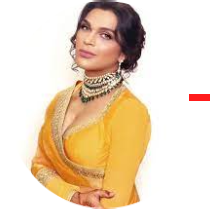Saisha Shinde
Saisha Shinde broke new ground as the first openly transgender designer to showcase at Lakme Fashion Week in its 25-year history. She was a 17-year old industry veteran who needed extraordinary courage and determination to gain acceptance. Saisha worked in the same fashion world she would later need to come out to, and faced unknown challenges for seventeen years.
CEO’s | Actors | Politicians | Sports Stars
The talented fashion designer Saisha Shinde stepped into unknown territory to reveal her authentic self to the industry. Her transition became one of the most important milestones in her life and revolutionised Indian fashion. No one had walked this path before at the prestigious Lakme Fashion Week. She emerged not just as a designer but as a pioneer who opened doors for representation.

From Swapnil to Saisha: A Journey of Identity
Early life and background
Mumbai Roots: Saisha Shinde was born in 1981 in Dadar, Mumbai to a well-to-do Marathi family. Her father, Tulsidas Shinde, ran successful restaurants and played a key role in supporting her talents and dreams. Her childhood years were rich with various influences that later shaped her creative path.
Childhood Struggles: Saisha’s feminine features showed up early, making her a target for bullies. Her classmates would mock her with taunts like “aye, baila” because she was shy and feminine. She remembers those school years as “the worst years of my life” and often sought peace alone. “The church on the school premises became a refuge, where I would wait in a corner until everyone else had left for the day,” she recalls.
Internal Conflict: Saisha felt trapped living a life that wasn’t truly hers, yet social pressure forced her to keep up appearances. “All through school and college, while the boys outside tormented me because I was different, the internal pain was far worse,” she shared. This inner battle pushed her to adopt hyper-masculine behaviours and looks in the early ’90s, when gay men were often reduced to caricatures.
Coming to terms with gender identity
NIFT Breakthrough: Saisha’s twenties at the National Institute of Fashion Technology (NIFT) brought her closer to self-acceptance. “I truly bloomed,” she revealed. She spent several years identifying as gay, thinking her attraction to men meant she was homosexual.
The Revelation: Therapy sessions helped Saisha embrace her true identity about six years before she went public. Professional help led her to learn about her gender dysphoria—distress from a mismatch between gender identity and assigned sex at birth. “I come from a privileged family and was financially sorted as a designer. It was easier to live in denial, but I realised that something was not right,” she explained.
Hidden Life: Saisha lived between genders during her self-discovery phase and kept her true self hidden from friends. “My friends didn’t know that I was wearing makeup and heels and dressing up behind closed doors. I was living between genders; I felt like a woman who dressed up as a man in rugged boots and a stubble, not the other way around,” she confessed. Her inner turmoil led to anxiety attacks and dependence on medication.
The decision to transition publicly
Lockdown Clarity: The 2020 pandemic lockdown changed everything for Saisha. “The 2020 lockdown brought all our fears to the forefront. There was no escape, you just had to deal with them. This was mine,” she shared. Her decision that May helped ease her peak levels of panic attacks, anxiety, and depression.
Medical Journey: Medical professionals confirmed Saisha’s identity before her gender reassignment surgery. She started with psychiatric sessions with Dr. Neha Shah and Dr. Armaan Pandey, then moved to hormone replacement therapy with endocrinologist Dr. Dheeraj Kapoor at Kokilaben Dhirubhai Ambani Hospital in Mumbai. The path wasn’t smooth—the first three psychiatrists advised against surgery, saying she was “too handsome” and her feelings were “just a phase”.
Family Support: Saisha’s family stood firmly by her side throughout her transition. Her “very liberal-minded” father supported every step—from buying dolls during childhood to backing her fashion career and gender transition. Her mother needed a day to process but later helped choose her new name, Saisha, meaning “a meaningful life”.
Public Revelation: Saisha announced her identity as a transwoman on social media on January 5, 2021. “I spent the next few years believing that I was attracted to men because I was gay, but it was only 6 years ago that I finally accepted to myself, and today that I accept to you. I’m not a gay man. I am a Transwoman,” she wrote. This moment opened a new chapter in her life, both personal and professional.
Industry Response: The response surprised Saisha positively, contrary to her fears of negativity and trolling. “I have received so many positive messages from not just LGBTQI+ people, but a number of women are writing to me saying how this news gives them courage and inspiration to live their lives without fear,” she shared. This support confirmed her belief that “if you give love, you only receive love”.
Breaking into Fashion: The Early Years
Original struggles in the fashion industry
Educational Foundation: Saisha Shinde (formerly Swapnil) graduated from the National Institute of Fashion Technology (NIFT) in Mumbai in 2003. She then completed a six-month internship at the prominent House of Versace in Italy. This experience improved her understanding of global fashion techniques and aesthetics by a lot. Her time in Italy played a vital role in developing her design philosophy and approach.
Early Career Steps: Saisha’s professional trip began at Kimaya Fashion Store in Mumbai. She started as a salesperson and worked her way up to become a visual merchandiser. Her retail positions helped her develop vital skills in understanding customer priorities and visual presentation that later became her signature style. During her time at NIFT, she came out as a gay man.
Identity Conflicts: School bullying about her feminine features led Saisha to adopt hyper-masculine behaviours and appearances early in her career. “After spending much of my school life feeling like less of a man, I decided to make my behaviour and appearance hyper masculine. It was a 100 per cent conscious decision,” she revealed. The clash between her professional image and true self created major challenges as she tried to find her place in the fashion industry.
Designing under a different name
Brand Beginnings: Saisha launched her fashion brand in 2007 under her birth name, Swapnil Shinde. The label quickly earned recognition for elegant, sophisticated womenswear with meticulous attention to detail and luxurious aesthetics. Her signature style showcased red-carpet gowns and cocktail dresses with nipped waists and carefully planned hemlines.
Celebrity Clientele: Early in her career, Saisha created designs for many high-profile Bollywood personalities. Her client list included Kareena Kapoor Khan, Deepika Padukone, and Aditi Rao Hydari. She also worked with stars like Shraddha Kapoor, Anushka Sharma, and Sunny Leone. Her talent for creating glamorous looks for a variety of body types made her a go-to designer for formal occasions and red-carpet events.
Public Persona vs. Private Reality: Saisha’s public image contrasted sharply with her true self. “Everyone knew Swapnil Shinde as this rugged guy with a gothic sense of style. But on the inside, I was the complete opposite,” she confessed. This split affected her personal wellbeing and creative expression. She later described it as “inner turmoil” that showed up in her work and even her signature, which she noted “would look different all the time”.
Finding a voice through design
Lakmé Fashion Week Debut: The Saisha Shinde label (then called Swapnil Shinde) first appeared at Lakmé Fashion Week in the Gen Next class of 2006. This platform pushed her into mainstream fashion recognition and helped establish her brand in India’s competitive fashion scene. She built a long-lasting relationship with this prestigious event that would span multiple seasons.
Design Evolution: Saisha’s brand has grown over 18 seasons. Each collection shows her deeper understanding of herself as a designer. “As each season has gone by, my understanding of who I am as a designer has gotten refined. I believe I made costumes before, but today I make outfits that people can actually wear,” she reflected. Her skills in draping, construction and pattern making improved by a lot during this time.
Creative Expression: Fashion gave Saisha a vital platform to express herself during identity struggles. “As a medium of self-expression, most definitely. The world really underestimates fashion’s ability to make you feel powerful,” she stated. Whatever personal challenges she faced, her designs for women earned praise for their ability to flatter and improve, showing her natural understanding of feminine aesthetics before fully embracing her own womanhood.
Turning Point: Saisha’s creative direction took a radical alteration at Lakmé Fashion Week in February 2020 with her collection “Not-The Cool Girl”. This collection explored gender fluidity and showed a more authentic version of her evolving identity, unlike her previous commercial work. This creative change aligned with her personal trip toward self-acceptance and hinted at her upcoming public transition.
The Intertwined Collection: Art Meets Activism
Inspiration behind the collection
Musical Genesis: A song sparked the creation of the Intertwined Collection. “I was listening to the song ‘Kashmir’ by The Yellow Diary on loop… and that’s how the idea of taking inspiration from Kashmir came around,” Saisha revealed. Her creative spark ignited after she designed a custom-made outfit for Bollywood star Deepika Padukone. The outfit featured a criss-cross trellis weave that became her signature element.
Architectural Fascination: Structural elements have always shaped Saisha’s designs. “I’ve always been fascinated by architecture and local crafts,” she explained about the collection’s creative roots. This love for form and structure became the life-blood of her most authentic creative expression.
Symbolism of Kashmir and trans identity
Beautiful Yet Battling: Kashmir and transgender identity are the emotional heart of the collection. “The idea of Kashmir was important because it’s battling and at the same time it’s beautiful. It’s pretty much what trans-women in this country are, they are beautiful but they are battling,” Saisha articulated. Her powerful comparison lifts the collection beyond fashion into a statement about resilience against adversity.
Personal Resonance: Saisha spent seventeen years dealing with what she called a “confused identity”. Her personal experience matched Kashmir’s complex story—both weaving beauty with struggle—making the collection deeply personal yet universal.
Design elements and cultural references
Geometric Precision: Khatam-band influences the collection’s core aesthetic. “The Kashmiri specialty of wood carving known as Khatam-band which has geometrical patterns beautifully done on the wood”. These intricate patterns evolved into structured yet flowing garments that celebrate traditional craftsmanship through modern fashion.
Landscape Palette: Natural colours “from its beautiful landscape” define the collection’s palette. Kashmir’s mountains, lakes, and valleys inspired authentic hues that enhanced the collection’s message beyond traditional fashion boundaries.
Dual Elements: “Since I transitioned, everything I do is going to be a part of my transformation. As Saisha, my focus on the hard and the soft, the male and the female, is all intertwined,” she explained. Contrasting elements—rigidity and fluidity, structure and softness—became the collection’s signature.
Why this collection was a turning point
Historic Representation: Lakme Fashion Week witnessed its first openly transgender designer in 25 years through the Intertwined Collection. This milestone altered the map of Indian fashion, creating space for transgender visibility on the runway.
Artistic Clarity: Saisha admitted that “my early collections lacked cohesiveness. My personal confusion reflected in my clothes”. The Intertwined Collection emerged from her authentic self. “Now that I am finally my full self, there is a great deal of clarity,” she acknowledged. Her transition shaped her creative vision powerfully.
Beyond Tokenism: True inclusivity needs more than occasional recognition. “Inclusivity should not be limited to a once-a-year tokenism in the Pride Month!” she claimed. This collection reflects her steadfast dedication to meaningful representation rather than momentary visibility.
Representation and Resistance in Indian Fashion
Being the first openly transgender designer at LFW
Historic Milestone: Saisha Shinde broke new ground as the first openly transgender designer in Lakme Fashion Week’s 25-year history. She evolved from a seasoned industry professional into a pioneering voice for her underrepresented community.
Industry Impact: “It was both shocking and surprising. I thought there would be a lot of trolling on social media when I came out, but I received so many positive messages, and not just from LGBTQI+ people”, Saisha shared about the overwhelming support after her transition.
Challenges within the LGBTQ+ community
Internal Discrimination. “Historically speaking and to some extent even today, the cisgender gay community tends to be exclusionary of the transgender community”. This reality shows how transgender individuals face unique obstacles even within LGBTQ+ spaces.
Pronoun Struggles: “I get annoyed when I have to correct someone four times, six times, ten times,” Saisha mentioned on reality show Lock Upp. Her statement highlights how misgendering remains a constant challenge.
Navigating cisgender-dominated spaces
Daily Battles: “I might be wearing an anarkali with jewellery and everything that’s as feminine as could be, but I still get called ‘sir’ sometimes, because of my height, my body frame or my voice”. Saisha’s experiences reveal the everyday challenges she faces.
Physical Expectations: “One of the battles that I have faced pretty much all my life is my weight. I am six-feet tall and I’m broad. There’s a preconceived idea about how women look”. Her words reflect society’s narrow beauty standards.
The importance of queer joy and visibility
Representation Matters: “When a celebrity comes out publicly, it bolsters the movement… when you see people who you look up to come out, it gives you that extra strength to be who you are, unabashedly”. These words underscore visibility’s crucial role.
Beyond Tokenism: “Inclusivity is about including those things that weren’t there before; it should not be limited to a once-a-year tokenism in the Pride Month!” Saisha emphasised, pushing for genuine representation throughout the year.
The Power of Visibility: Saisha’s Broader Impact
Saisha Shinde’s remarkable experience from a bullied child to a celebrated fashion designer represents a watershed moment for transgender representation in Indian fashion. She showed extraordinary courage against societal expectations and industry norms during her transformation from Swapnil to Saisha. Her decision to live authentically after seventeen years in the fashion industry required tremendous bravery, especially since she had no predecessors to follow in the prestigious Lakme Fashion Week environment.
The Intertwined Collection stands as powerful proof of Saisha’s artistic vision and personal truth. She transformed fashion into a medium for profound storytelling by drawing parallels between Kashmir’s complex beauty and the transgender experience. Her thoughtful incorporation of Khatam-band patterns and Kashmir’s natural palette shows how personal authenticity boosts creative expression rather than limiting it.
Saisha has persevered with grace and determination while facing discrimination both within and outside the LGBTQ+ community. Her struggles with misgendering, body image expectations, and societal preconceptions highlight the daily challenges transgender individuals face, even after publicly transitioning. The overwhelming positive reception from industry peers and fans suggests that authenticity deeply appeals to audiences hungry for genuine representation.
Saisha’s significance reaches way beyond her personal triumph. She has effectively created space for others to follow as the first openly transgender designer at Lakme Fashion Week in its 25-year history. Her insistence that inclusivity must exceed tokenism and exist year-round rather than merely during Pride Month underscores her steadfast dedication to meaningful change within the fashion industry.
Saisha Shinde’s story clarifies how personal transformation can spark broader social progress. Her path from hiding behind a hypermasculine facade to embracing her authentic self mirrors the fashion industry’s gradual movement toward genuine inclusivity. Barriers remain for transgender individuals in fashion and beyond, but Saisha’s groundbreaking presence has altered what’s possible for future generations of designers seeking to express their truth through their art.
Key Takeaways
Saisha Shinde’s groundbreaking journey reveals how authentic self-expression can transform both personal artistry and entire industries, whilst highlighting the ongoing challenges faced by transgender individuals in professional spaces.
- Saisha became the first openly transgender designer in Lakme Fashion Week’s 25-year history, breaking barriers after 17 years in the industry
- Her “Intertwined Collection” powerfully paralleled Kashmir’s beauty-amid-struggle with transgender experiences, transforming fashion into meaningful activism
- Despite overwhelming positive response to her transition, daily challenges persist including misgendering and societal expectations about feminine appearance
- Personal authenticity enhanced rather than limited her creative vision, with collections gaining clarity and cohesiveness after her transition
- Her visibility creates crucial representation for transgender youth, proving that living authentically can inspire broader social change
Saisha’s story demonstrates that true inclusivity requires year-round commitment beyond tokenistic gestures, whilst her success paves the way for future generations of transgender designers to express their truth through their art.
Also Read: Journey of Paris Laxmi
FAQ:
What is Saisha Shinde’s gender?
Saisha Shinde is a transgender woman.
Who is Saisha Shinde?
An Indian fashion designer (formerly known as Swapnil Shinde), widely recognized as India’s first openly transgender fashion designer.
What is the connection between Saisha Shinde and Munawar Faruqui?
They appeared together on the reality show Lock Upp, where Saisha expressed admiration for Munawar and highlighted his respectful behavior toward her.
Does Saisha Shinde have a brother?
No. She has mentioned having an elder sister who passed away.




